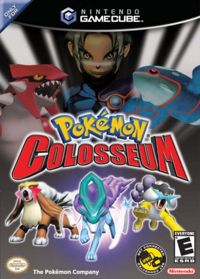Pokémon Colosseum

| |
| Pokémon Colosseum | |
| Developer | Genius Sonority |
| Publisher | Nintendo |
| System | Nintendo Gamecube |
| Release Date | JP November 21, 2003 US March 22, 2004 EU May 14, 2004 |
| Rating | ESRB: E |
Pokémon Colosseum is the Nintendo Gamecube successor to the Pokémon Stadium games, but it differentiates itself from the previous games with an original RPG adventure.
Story[edit]
The player controls Wes (who, like the protagonists of the color versions, can have his name chosen by the player), a mysterious teenager who has just betrayed and escaped the criminal organization Team Snagem. This game follows his adventure as he partners up with Rui, a young girl with the ability to identify Shadow Pokémon, in a journey throughout Orre to defeat the mysterious organization Cipher and to capture and purify as many of the Pokémon that they had tainted and turned into Shadow Pokémon.
Gameplay[edit]
The game has only a few different modes, removing the Gym Leader Castle, minigames and various other features that had been in the Nintendo 64 games. The main mode is an RPG game with gameplay similar to the handheld color version games, but with notable differences. The most notable is that there are no encounters with wild Pokémon, and the only way to capture Pokémon is by using special Pokéballs to "snag" an enemy's Shadow Pokémon. Additionally, all battles take place in the form of double battles. And unlike the handheld games, the main purpose of the game does not involve Pokémon gym leaders nor an Elite Four, as there is only one optional Pokémon gym, and instead the game is based around battling members of Cipher and the trainers that they have distributed Shadow Pokémon to.
Only Shadow Pokémon can be captured, and they must go through a long process to be purified. A meter represents how closed off the Pokémon's heart is, and the meter goes down as the Pokémon is pleased (but it never rises back up). Once the meter is down completely, it can be restored at a shrine in the Relic Forest.
Pokémon Colosseum also has more traditional battle modes, where players can use either non-shadow Pokémon from an adventure mode or Pokémon transferred from one of the Gameboy Advance games
Connectivity[edit]
Pokémon Colosseum could link with Pokémon Ruby, Sapphire, Emerald, FireRed and Leafgreen Versions using the Gameboy Advance-Gamecube link cable. Through this, players could use their teams in Battle Mode competitions, or trade with a completed Pokémon Colosseum Story Mode, although only purified Pokémon could be traded. This game and its sequel were important sources for finding Pokémon from the first two generations that were unavailable in the third generation games (although after the release of FireRed and LeafGreen it was still important for some exclusive second generation Pokémon).
Legacy[edit]
Sequels[edit]
It was followed by Pokémon XD: Gale of Darkness, which had similar features and was set after the events of Colosseum.